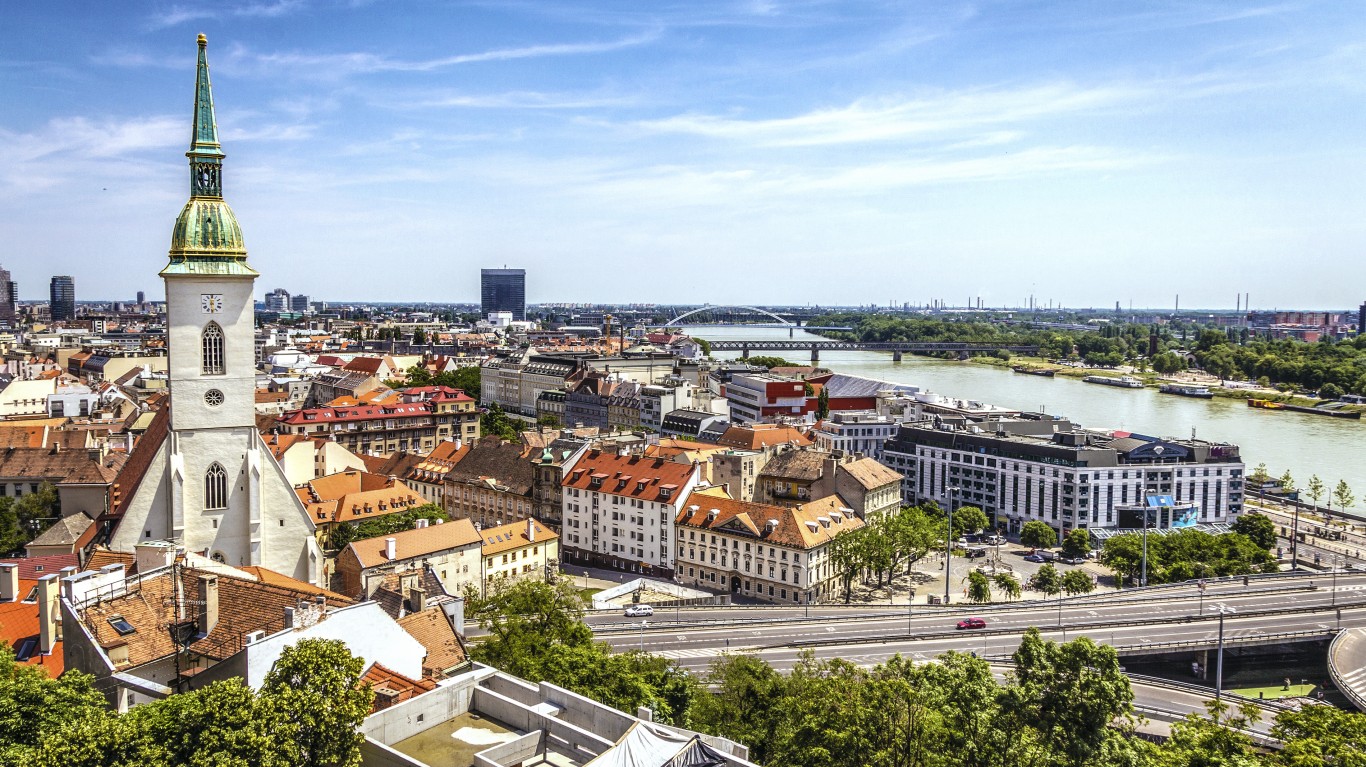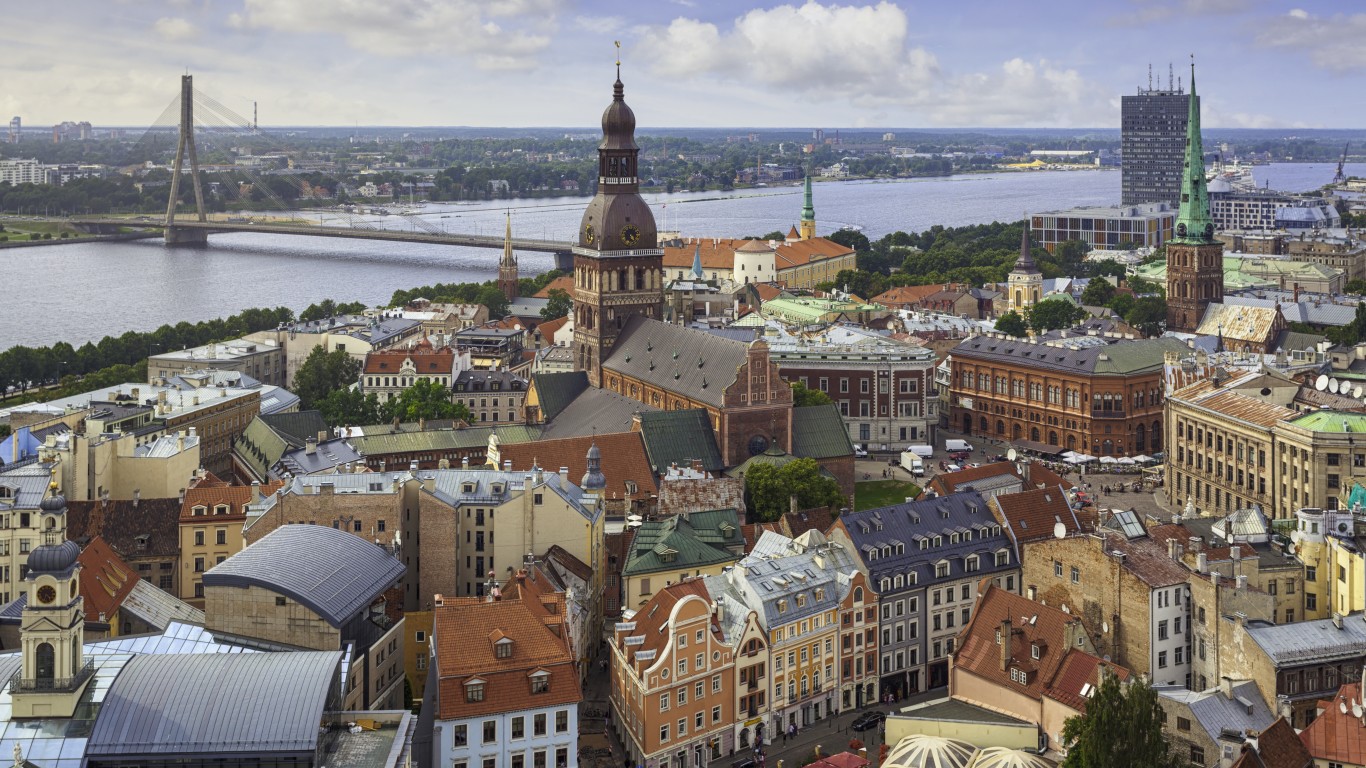
About 1 in every 6 deaths on the planet is due to cancer, the second leading cause of death worldwide. In the United States alone, the cost of cancer care amounts to approximately $157 billion in medical expenditures per year. As the global population ages, the prevalence of cancer is likely to increase, as will the costs of care as more advanced, expensive treatments become the medical standard.
Correlated with factors like age, income, and health behaviors, the incidence of cancer varies heavily around the world. While the quality of medical treatment and access to health care is worse in poorer, developing nations, age is the main risk factor for cancer, and many of the countries with the highest incidence of cancer are wealthy, developed nations with high life expectancy.
To determine the countries with the highest incidence of new cancer cases, 24/7 Wall St. reviewed the estimated age-adjusted new cancer diagnosis rates for 185 countries in 2018 with data from the World Health Organization’s International Agency for Research on Cancer.
Click here to see the countries with the highest cancer rates.
Click here to read our detailed findings and methodology.

25. Croatia
> Cancer diagnosis rate: 287.2 new cases per 100,000 residents
> Life expectancy at birth: 78.0 years
> Annual health expenditure per capita: $1,656
> Population 65 and over: 19.7%
[in-text-ad]

24. Italy
> Cancer diagnosis rate: 290.6 new cases per 100,000 residents
> Life expectancy at birth: 82.5 years
> Annual health expenditure per capita: $3,351
> Population 65 and over: 23.0%

23. Sweden
> Cancer diagnosis rate: 294.7 new cases per 100,000 residents
> Life expectancy at birth: 82.2 years
> Annual health expenditure per capita: $5,299
> Population 65 and over: 20.0%

22. Czech Republic
> Cancer diagnosis rate: 296.7 new cases per 100,000 residents
> Life expectancy at birth: 78.3 years
> Annual health expenditure per capita: $2,470
> Population 65 and over: 19.0%
[in-text-ad-2]

21. Slovakia
> Cancer diagnosis rate: 297.5 new cases per 100,000 residents
> Life expectancy at birth: 76.6 years
> Annual health expenditure per capita: $2,062
> Population 65 and over: 15.1%

20. Latvia
> Cancer diagnosis rate: 302.2 new cases per 100,000 residents
> Life expectancy at birth: 74.5 years
> Annual health expenditure per capita: $1,429
> Population 65 and over: 19.8%
[in-text-ad]

19. Slovenia
> Cancer diagnosis rate: 304.9 new cases per 100,000 residents
> Life expectancy at birth: 80.8 years
> Annual health expenditure per capita: $2,734
> Population 65 and over: 19.1%

18. Serbia
> Cancer diagnosis rate: 307.8 new cases per 100,000 residents
> Life expectancy at birth: 75.2 years
> Annual health expenditure per capita: $1,324
> Population 65 and over: 17.4%

17. Luxembourg
> Cancer diagnosis rate: 309.3 new cases per 100,000 residents
> Life expectancy at birth: 82.3 years
> Annual health expenditure per capita: $6,382
> Population 65 and over: 14.3%
[in-text-ad-2]

16. Switzerland
> Cancer diagnosis rate: 311.0 new cases per 100,000 residents
> Life expectancy at birth: 82.9 years
> Annual health expenditure per capita: $7,583
> Population 65 and over: 18.4%

15. Germany
> Cancer diagnosis rate: 313.1 new cases per 100,000 residents
> Life expectancy at birth: 80.6 years
> Annual health expenditure per capita: $5,357
> Population 65 and over: 21.5%
[in-text-ad]

14. South Korea
> Cancer diagnosis rate: 313.5 new cases per 100,000 residents
> Life expectancy at birth: 82.0 years
> Annual health expenditure per capita: $2,556
> Population 65 and over: 13.9%

13. United Kingdom
> Cancer diagnosis rate: 319.2 new cases per 100,000 residents
> Life expectancy at birth: 81.0 years
> Annual health expenditure per capita: $4,145
> Population 65 and over: 18.5%

12. New Caledonia
> Cancer diagnosis rate: 324.2 new cases per 100,000 residents
> Life expectancy at birth: 77.0 years
> Annual health expenditure per capita: N/A
> Population 65 and over: 10.0%
[in-text-ad-2]

11. Canada
> Cancer diagnosis rate: 334.0 new cases per 100,000 residents
> Life expectancy at birth: 82.3 years
> Annual health expenditure per capita: $4,600
> Population 65 and over: 17.0%

10. The Netherlands
> Cancer diagnosis rate: 334.1 new cases per 100,000 residents
> Life expectancy at birth: 81.5 years
> Annual health expenditure per capita: $5,313
> Population 65 and over: 18.8%
[in-text-ad]

9. Norway
> Cancer diagnosis rate: 337.8 new cases per 100,000 residents
> Life expectancy at birth: 82.5 years
> Annual health expenditure per capita: $6,222
> Population 65 and over: 16.8%

8. Denmark
> Cancer diagnosis rate: 340.4 new cases per 100,000 residents
> Life expectancy at birth: 80.7 years
> Annual health expenditure per capita: $5,083
> Population 65 and over: 19.7%

7. France
> Cancer diagnosis rate: 344.1 new cases per 100,000 residents
> Life expectancy at birth: 82.3 years
> Annual health expenditure per capita: $4,542
> Population 65 and over: 19.7%
[in-text-ad-2]

6. Belgium
> Cancer diagnosis rate: 345.8 new cases per 100,000 residents
> Life expectancy at birth: 81.0 years
> Annual health expenditure per capita: $4,782
> Population 65 and over: 18.6%

5. United States
> Cancer diagnosis rate: 352.2 new cases per 100,000 residents
> Life expectancy at birth: 78.7 years
> Annual health expenditure per capita: $9,536
> Population 65 and over: 15.4%
[in-text-ad]

4. Hungary
> Cancer diagnosis rate: 368.1 new cases per 100,000 residents
> Life expectancy at birth: 75.6 years
> Annual health expenditure per capita: $1,912
> Population 65 and over: 18.6%

3. Ireland
> Cancer diagnosis rate: 373.7 new cases per 100,000 residents
> Life expectancy at birth: 81.6 years
> Annual health expenditure per capita: $5,335
> Population 65 and over: 13.9%

2. New Zealand
> Cancer diagnosis rate: 438.1 new cases per 100,000 residents
> Life expectancy at birth: 81.6 years
> Annual health expenditure per capita: $3,530
> Population 65 and over: 15.3%
[in-text-ad-2]

1. Australia
> Cancer diagnosis rate: 468.0 new cases per 100,000 residents
> Life expectancy at birth: 82.5 years
> Annual health expenditure per capita: $4,492
> Population 65 and over: 15.5%
Detailed Findings
The highest rates of new cancer diagnosis are found in wealthy, Western nations. Developed nations have greater medical advances and high incomes that contribute to longer lifespans, which increases the likelihood of cancer. In 24 of the 25 countries with the highest incidence of cancer, the gross national income per capita is greater than the global average income per capita of $15,071.
As a body ages, tissue and organ cells become more susceptible to cancer-causing mutations. Additionally, older individuals have had greater exposure to cancer-causing factors such as sunlight, radiation, air pollution, and other substances over their lifetimes. According to data from the National Cancer Institute, the median age for a cancer diagnosis in the United States is 66 years.
In all of the 25 countries with the highest incidence of new cancer cases, the share of the population that is 65 and older is greater than the 8.7% global average. Additionally, the average life expectancy at birth in all 25 countries is greater than the 72-year global average.
While many of the wealthier, developed nations have the highest rates of cancer incidence, cancer patients in the countries are far less likely to die from the disease than in poorer, developing countries. Wealthier nations have a higher quality of medical care, greater access to health care, and higher survival rates overall. In 22 of the 24 countries with the highest cancer prevalence and for which data is available, the mortality rate from cancer, cardiovascular disease, diabetes, and chronic respiratory disease for 30 to 70 year olds is below the 18.8% global figure.
According to research published in October 2017 by the University of Adelaide, the low cancer mortality rates in wealthy Western nations may also partially contribute to the high rates of cancer incidence. In countries with low cancer mortality rates, cancer survivors are more likely to reproduce and pass cancer genes and mutations to the next generation.
The high incidence of cancer in high-income countries may be also due to the high prevalence of lifestyle risk factors such as smoking, obesity, and alcohol intake. In Serbia, for example, a country with one of the lower GNI per capitas and life expectancies of the 25 countries on this list, 39.0% of adults smoke, nearly twice the 19.9% global figure and one of the highest smoking rates of any country, according to data from the World Health Organization. The high prevalence of smoking in Serbia — as well as other high smoking rate Eastern European nations such as Latvia and Croatia — may account for an outsized share of cancer cases in the country.
The high rate of cancer diagnosis in wealthier countries may also be attributable to the more advanced and easily accessible detection and diagnosis methods in the developed world. While only 26% of low-income countries report having pathology services available in the public sector, more than 90% of high-income countries report having treatment services available. As a result, cancer is more likely to be undiagnosed, untreated, and underreported, further contributing to the disparity in cancer diagnosis between rich and poor nations.
Methodology
To determine the countries with the highest incidence of new cancer cases, 24/7 Wall St. reviewed the estimated age-adjusted new cancer diagnosis rates for 185 countries with data from the World Health Organization’s International Agency for Research on Cancer. Age-adjusted rates for all cancers are for both sexes and are for 2018. Data on GNI per capita, health expenditure per capita, and life expectancy are from the World Bank and are for the most recent year available for that country. Data on adult smoking rate for the population 15-years and older is from the World Health Organization. All data is for the most recent period available.
100 Million Americans Are Missing This Crucial Retirement Tool
The thought of burdening your family with a financial disaster is most Americans’ nightmare. However, recent studies show that over 100 million Americans still don’t have proper life insurance in the event they pass away.
Life insurance can bring peace of mind – ensuring your loved ones are safeguarded against unforeseen expenses and debts. With premiums often lower than expected and a variety of plans tailored to different life stages and health conditions, securing a policy is more accessible than ever.
A quick, no-obligation quote can provide valuable insight into what’s available and what might best suit your family’s needs. Life insurance is a simple step you can take today to help secure peace of mind for your loved ones tomorrow.
Click here to learn how to get a quote in just a few minutes.
Thank you for reading! Have some feedback for us?
Contact the 24/7 Wall St. editorial team.
 24/7 Wall St.
24/7 Wall St. 24/7 Wall St.
24/7 Wall St. 24/7 Wall St.
24/7 Wall St.



